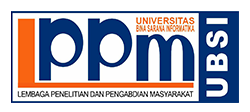Identitas Diri pada Media Sosial (Konstruksi Sosial dan Potensi Rumor Pengguna Instagram)
Abstract
Abstract - It is undeniable that Instagram social media has entered in all aspects of communication. At first Instagram just sharing moments of photos and videos and then used for trading and spreading information. Instagram let anyone has the opportunity to attract other user attention by doing social construction from its of the contents through his Instagram account. This research attempts to describe the social construction that occurs and its potential in the dissemination of rumors on social media Instagram. With a qualitative descriptive approach revealed that Instagram users in this case the students are aware of and do message construction in order to get the attention of other users. They also understand that Instagram social media has the potential to spread rumors to the public.
Keywords: social media,instagram, social construction, rumors
Abstrak
Tidak dapat dipungkiri bahwa media sosial Instagram telah masuk di semua aspek berkomunikasi. Mulai dari sekadar berbagi momen foto dan video sampai digunakan untuk berniaga dan menyebar informasi. Melalui Instagram ini siapapun berkesempatan untuk menarik perhatian warganet dengan melakukan konstruksi sosial terhadap isi pesan yang akan dibagi melalui akun Instagramnya. Penelitian ini berupaya untuk mendeskripsikan konstruksi sosial yang terjadi serta potensinya dalam penyebaran rumors di media sosial Instagram. Dengan pendekatan deskriptif kualitatif tersingkap bahwa pengguna Instagram menyadari dan melakukan konstruksi pesan agar bisa memperoleh perhatian dari pengguna lainnya. Mereka juga memahami bahwa media sosial Instagram memiliki potensi dalam penyebaran rumor pada masyarakat.
Kata Kunci : media sosial, instagram, konstruksi sosial, rumor
Keywords
Full Text:
PDFReferences
Amelia R, M., Koesmawardhani, N. W., & Mappapa, P. L. (2016, Desember 30). Kapolda Metro: Hoax di Medsos Jadi Bisnis, Perlu Ditemukan Pengorder. detiknews. Diambil dari https://news.detik.com/wawancara/d-3384601/kapolda-metro-hoax-di-medsos-jadi-bisnis-perlu-ditemukan-pengorder
Berger, P. L., & Luckmann, T. (2011). The Social Construction Of Reality. New York: Open Road Integrated Media.
Bugiardo. (2015). Berkomunikasi Ala Net Generation Jakarta. Jakarta: Elex Media Kumputindo.
Bungin, M. B. (2015). Sosiologi Komunikasi, Teori, Paradigma dan Diskursus Teknologi Komunikasi di Masyarakat. Jakarta: Kencana Prenadamedia Group.
Castronova, E. (2008). Exodus To The Virtual World. New York: St. Martin’s Griffin.
Croteau, D., Hoynes, W., & Milan, S. (2012a). Media Society: Industries, Images and Audiences. California: Sage Publication.
Croteau, D., Hoynes, W., & Milan, S. (2012b). Media Society: Industries, Images and Audiences. California: Sage Publication.
Goffman, E. (1999). The Presentation of Self in Everyday Life. New York: Anchor Books/Doubleday.
Hardiman, F. B. (2018). Homo Digitalis-Kondisi Manusia di Era Komunikasi Digital. Etika Komunikasi Digital Membela Moralitas Dalam Prahara Politik Pasca Kebenaran. Dipresentasikan pada Seminar Dies Natalis 49 Sekolah Tinggi FIlsafat Driyakarya.
Hu, Y., Manikonda, L., & Kambhampati, S. (2014a). What We Instagram: A First Analysis of Instagram Photo Content and User Types. Departemen of Computer Science. Dipresentasikan pada Proceedings of the Eighth International AAAI Conference on Weblogs and Social Media, Arizona. Diambil dari https://www.aaai.org/ocs/index.php/ICWSM/ICWSM14/paper/view/8118/8087
Hu, Y., Manikonda, L., & Kambhampati, S. (2014b). What We Instagram: A First Analysis of Instagram Photo Content and User Types. Proceedings Of The Eighth International Conference On Weblogs And Social Media, 595–598. Diambil dari https://www.aaai.org/ocs/index.php/ICWSM/ICWSM14/paper/viewFile/8118/8087
Kaplan, A. M. (2012). If You Love Something, Let It Go Mobile: Mobile Marketing And Mobile Social Media 4x4. Elsevier Indiana University Indianapolis, 55(2), 129–139.
Kaplan, A. M., & Haenlein, M. (2010). Users of the World, Unite! The Challenges and Opportunities of Social Media. Elsevier Indiana University Indianapolis, 53(1), 59–68.
Lipschultz, J. H. (2017). Social Media Communication: Concepts, Practices, Data, Law and Ethics (Second Edition). New York: Routledge.
R, K., & Mohan, A. K. (2017). Inspecting Irresponsible Hypes: Rumors in Social Media Networks. International Journal on Computer Science and Engineering (IJCSE), 9, 333–337.
Respati, S., & Asril, S. (2017, Januari 23). Mengapa Banyak Orang Percaya Berita hoax? Kompas.com. Diambil dari https://nasional.kompas.com/read/2017/01/23/18181951/mengapa.banyak.orang.mudah.percaya.berita.hoax.
Severin, W. J., & Tankard, Jr, J. W. (2014). Communication theories: Origins, Methods and Uses in The Mass Media (Fifth edition). Harlow, United Kingdom Pearson.
Sloan, L., Quan, A., & Haase. (2017). Social Media Research Methode. California: Sage Publication.
Zubiaga, A., Liakata, M., Procter, R., Hoi, W. S., & Tolmie, P. (2016). Analysing How People Orient to and Spread Rumours in Social Media by Looking at Conversational Threads. Public Library of Science, 13, 1–29. https://doi.org/10.1371
DOI: https://doi.org/10.31294/jkom.v10i2.6411
E-ISSN: 2579-3292 | ||
  | ||
Dipublikasikan oleh LPPM Universitas Bina Sarana InformatikaJl. Kramat Raya No.98, Kwitang, Kec. Senen, Kota Jakarta Pusat, DKI Jakarta 10450 |






